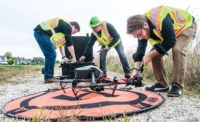Government bodies and technology companies in 10 locations across the nation are partnering to develop an array of drone innovations while the Federal Aviation Administration streamlines its airspace access request process.
“Our country is on the verge of the most significant new development in aviation since the beginning of the jet age,” said U.S. Transportation Secretary Elaine L. Chao in a press conference on May 9. “Our country has reached a tipping point.”
Spearheaded by the White House, the Unmanned Aircraft System Integration Pilot Program (IPP) creates open communications between the FAA, as well as state, local and tribal governments and select private industry partners. The IPP’s first-round initiative had 149 applicants. Ten were chosen.
The FAA says the selectees now will work with the department to establish the parties’ responsibilities and define specific concepts of operations to develop and establish data-sharing requirements. It’s a three-year plan with no federal funding but with lofty goals for expanding drone operations into areas now tightly restricted, including flying over populated areas, beyond visual line of sight, and at night.
IPP winners are required to commence operations by Aug. 15, says Greg McNeal, cofounder of AirMap, a platform that connects airspace managers and authorities with drone pilots. It is involved in six of the 10 awards and is working with other applicants to enable a variety of advanced commercial drone trials, including package delivery in North Carolina, agricultural surveying in Kansas, public safety in Choctaw Nation, emergency response in Reno, Nev., infrastructure inspection in North Dakota and medical delivery in San Diego, says McNeal.
“The drone testing program is to prove out the safety of these innovations so they can be used in the real world,” says Nelson Paez, CEO of DreamHammer Inc., a software company providing advanced drone management software for enterprise customers. “Nobody is getting any money, so there are the typical players who were doing this already—but now there will be a feedback loop where innovations can influence laws. It’s moving the ball in the right direction.”
Paez adds that the government’s initiative supporting innovation is welcome. “All the last administration did was legalize the rule sets they had for seven years,” says Paez. “There was no focus on business commercialization at all.”
Paez is not alone in his excitement over the IPP. “It’s a monumental step forward for the growth of the drone economy,” says McNeal. “We expect the IPP will create laboratories of innovation that will benefit not only the [unmanned aerial systems] industry, but also other emerging economies, including autonomous vehicles and advanced commercial aerospace.”
Partners involved in the IPP, such as Google parent company Alphabet Inc. and Amazon, also can bring deep pockets and an innovative mind-set.
“We’re grateful to the DOT and the FAA for providing us with the opportunity to conduct our most advanced testing to date on U.S. soil,” says James Ryan Burgess, co-lead of Project Wing, a drone delivery program by X Development LLC, a subsidiary of Alphabet Inc.
The FAA also announced a move toward directly integrating unmanned aircraft systems into U.S. airspace with its Low Altitude Authorization and Notification Capability. LAANC is an automated system that lets drone pilots apply for authorization to fly in restricted airspace. The application is checked for conflicts against airspace data and, if none is found, LAANC instantly delivers authorization.
“I love LAANC. It makes getting airspace permission using apps like AirMap a breeze for us professionals and intermediates alike,” says Lloyd Garden, an aerial cinematographer at Drone Promotions. “It’s much better now that the FAA has given us rules and ways to comply with them that are reasonable.”




